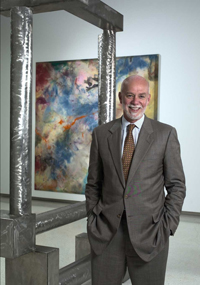 Guggenheim Eyes Armstrong as Its Director
Guggenheim Eyes Armstrong as Its DirectorBy KATE TAYLOR, Staff Reporter of the Sun | September 3, 2008
The Solomon R. Guggenheim Foundation is expected to name as its next director the outgoing director of the Carnegie Museum of Art in Pittsburgh, Richard Armstrong, sources have told The New York Sun.
Through a spokeswoman at the Carnegie, Mr. Armstrong confirmed last evening that he is in final negotiations with the Guggenheim. He would replace Thomas Krens, who stepped down in February to become a senior adviser to the foundation on international affairs, with leadership over the creation of a planned 452,000-square-foot Guggenheim in Abu Dhabi.
Representatives for the Guggenheim declined to comment on the negotiations.
If he accepts the position, Mr. Armstrong would run the Guggenheim's four existing museums, in New York; Bilbao, Spain; Venice, Italy, and Berlin. It is unclear what his role would be in the Abu Dhabi museum and whether he would share control over that project with Mr. Krens.
The Guggenheim has been looking for a new director for more than a year. Last summer, Lisa Dennison resigned as director of the New York museum, a position she had held for less than two years, to be a chairwoman at Sotheby's. The foundation convened a search committee to replace her, but the committee reportedly had difficulty finding candidates who were interested in working under Mr. Krens. When Mr. Krens resigned, the Guggenheim announced that it would revert to having one person run both the foundation and the museum in New York — a role that Mr. Krens filled until Ms. Dennison's promotion to director of the New York museum in 2005.
Mr. Armstrong, 59, has been the director of the Carnegie since 1996. He joined the museum as a curator of Contemporary art in 1992. Prior to that, he was a curator at the Whitney Museum of American Art, where he organized four biennials, as well as exhibitions on Richard Artschwager and "The New Sculpture 1965-7."
At the Carnegie, Mr. Armstrong is credited with overseeing the renovation of many of the museum's galleries and the purchase of significant pieces of Contemporary art — including the joint acquisition in 2006, with the Albright-Knox Art Gallery in Buffalo, of Rachel Whiteread's large-scale sculptural installation "Untitled (Domestic)" (2002). He announced his retirement from the Carnegie in June.
Mr. Armstrong grew up in Kansas City, Mo., and studied at the University de Dijon and the Sorbonne before getting a bachelor's degree in art history from Lake Forest College in Illinois.
The director of the Indianapolis Museum of Art, Maxwell Anderson, said in an e-mail message that Mr. Armstrong is "a seasoned director, who can both restore the Guggenheim's art world credentials and bring sound management." He said the appointment should elicit "a deep sigh of relief."
The director of the New Museum of Contemporary Art, Lisa Phillips, described Mr. Armstrong as a wonderful colleague and one of the top directors in the country. "He's got a passion for art and for institutions that is quite infectious," she said. At the Carnegie, she said, he "was incredibly successful at galvanizing the community and engaging a lot of young people with the museum."
Another major position in the field of Modern art was filled yesterday when the Museum of Modern Art appointed one of its curators, Ann Temkin, as the new head of its department of painting and sculpture, replacing John Elderfield, who recently retired. Ms. Temkin has been at MoMA since 2003. She has organized shows including "Against the Grain: Contemporary Art From the Edward R. Broida Collection" and "Color Chart: Reinventing Color, 1950 to Today."
Meanwhile, the Metropolitan Museum of Art is nearing a decision about who will replace its director of 30 years, Philippe de Montebello. The Met's search committee is supposed to have done final interviews last week with four candidates. Three are said to be Met curators: the curator-in-charge of 19th-century, Modern, and Contemporary art, Gary Tinterow; the head of the department of European sculpture and decorative arts, Ian Wardropper, and another curator in Mr. Wardropper's department, Thomas Campbell, whose specialty is tapestries.
Some sources have said that the fourth candidate is the director of the Städel Museum in Frankfurt, Germany, Max Hollein. Mr. Hollein reportedly was also contacted early on by the Guggenheim's search committee, but asked not to be considered for the job.
 Guggenheim Eyes Armstrong as Its Director
Guggenheim Eyes Armstrong as Its Director